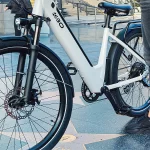Electric bikes are becoming increasingly popular in the United States. This is great, because electric bikes make cycling accessible for more people. They are a fun way for you to get exercise, whilst getting a great amount of outdoor time. If you wish to buy an electric bike in the United States though, you should be aware of the electric bike laws, for the state you’re based.
Electric bike laws are not consistent throughout the United States. They depend on which state you’re in. This can be a hindrance, that possibly puts people off buying an electric bike in the US. The reason for this is the possible confusion caused from the current lack of standardized electric bike laws, in the US as a whole.
The introduction of the electric bike 3 class system in 2014 is a step towards standardization in the US though. Here in this article, I will talk about this 3 class system. This is to give you an understanding of electric bike laws, in the states that have adopted this system. I will also talk a little about the states that have not currently adopted this 3 class system. This is to help give you an idea of how electric bike laws generally work in the United States, as a whole.
Table of Contents
The 3 Class System
This system allows for regulation of the speed and power of electric bikes. It also helps determine (and clarify) where you can ride electric bikes. Currently as it stands, just over half of all States (26 to be exact) have adopted this 3 class system.
As time goes on, we may see more states adopt this system. The more states that adopt this system, the less ambiguity and confusion there will be. This is with regard to whom, when, how and where you can ride electric bikes, in the US. Therefore, deploying this system helps towards giving people more confidence to buy an electric bike in the US. This contributes towards increasing their popularity.
The 3 class system is set at federal level and sets out 3 different classes of electric bike. The specifications of any given electric bike, will determine which one of these classes it comes under. Whichever class your electric bike is, determines where you’re allowed to ride it. This is as long as you’re within a particular state that uses this 3 class system.
If your electric bike falls within any of these 3 classes, it will not be classed as a motor vehicle. Again, that’s if you’re situated within a participating state, of this 3 class system. So there’s no requirement for you to have a license to ride it, as well as no requirement to insure, register and tax it.
Requirements
The electric bike requirements of these 3 different classes are below.
Class 1 – electric bikes feature motors that provide assistance exclusively when the rider is pedaling.
– Does not have a throttle to power the motor.
– The motor can only provide assistance up to 20mph.
– The motor must be less than 750 watts.
Class 2 – Has a throttle that can power the motor.
– Must have pedals, that can also power the motor.
– The motor can only provide assistance up to 20mph.
– The motor must be less than 750 watts.
Class 3 – Has a motor that only provides assistance when the rider is pedaling.
– Does not have a throttle to power the motor.
– The motor can only provide assistance up to 28mph.
– Must have a speedometer.
– The motor must be less than 750 watts.
As long as you’re physically able to. You can ride class 1 and 2 electric bikes, above 20mph, and class 3 electric bikes, above 28mph. However, the motor will not be assisting you at this point. The assistance from the motor will cut out, once you reach the maximum permitted, motor assisted speed.
Any of these classes of electric bikes can have 2 or 3 wheels, by the way. So you could have an electric tricycle under any 1 of these classes.
You may notice a couple of consistencies throughout all 3 of these classes. These are that the motor must be under 750 watts of power and that the bike must have pedals.

Where Can You Ride Your Class of Electric Bike?
Remembering that the class your electric bike falls within determines where you can ride it, it’s worth taking into account the below.
Class 1 and 2 electric bikes – Permitted on dedicated bicycle paths and trails by default.
Class 3 electric bikes – Banned from dedicated bicycle paths and trails by default.
Even with the above in mind, local laws can override this. So, you could still come by a bicycle trail, that has a sign saying that riding class 3 electric bikes is permitted.
When it comes to this class system, the below factors apply.
- The 3 class system establishes how electric bikes are defined.
- Individual states and local laws decide where you can ride the different class of electric bikes. This is as long as these states and local laws use this system.
Ultimately, states and local laws can permit or ban any class of electric bike, on any dedicated bicycle paths and trails.
Generally speaking, though, you will typically expect states that use the 3 class system to permit you to ride class 1 electric bikes, anywhere you can ride regular bikes. This can include bicycle lanes or paths, multi-use trails and roads. You can generally expect the same for class 2 electric bikes as well, in most states that use the system. Some states and local governments, though, may ban riding class 2 electric bikes, on dedicated mountain bike trails. This can even sometimes be the case for class 1 electric bikes. There can be concern that using the throttle could cause damage to these trails.
Even though class 3 electric bikes are banned on dedicated bicycle paths and trails by default. You’ll expect the permission of class 3 electric bikes on roads and on-road bike lanes. Again, local laws and states can still ban this, if they choose. It’s generally considered too dangerous to ride class 3 electric bikes on regular bicycle paths and trails. This is due to the fact that they are capable of motor assisted speeds of up to 28mph.
Labeling the Class of Electric Bike
An electric bike that falls within any of these 3 classes must have a label identifying which class it is. This label must meet particular requirements though, which are as below:
- Be in a prominent position
- Contain the class classification number
- Show the top assisted speed
- Display the motor wattage
- Must be printed in arial font, of at least 9 point type
You can buy stickers and labels that specify the class of your electric bike, online. A particularly good website for purchasing these is Boltonebikes.com.
Labeling the Class of Your Electric Bike After Making Modifications
A useful point to consider is that the law permits you to modify your electric bike. After making the modifications, a label confirming the class it falls within is still required though. This is as long as your electric bike is still within the confines of these 3 classes,
You may have to replace the original label with a new one, if the modifications you have made have changed the class of your electric bike. For example, you may add a throttle to a class 1 electric bike, but the motor may still only assist up to 20mph. This would make the electric bike a class 2. Here, you would need to replace the label stating the electric bike as a class 1, with a new label stating it is a class 2.
You can modify an electric bike, so that it is no longer within the confines of the 3 class system. For example, upgrading a class 3 electric bike, so that the motor is more than 750 watts and can assist with speeds past 28mph. Here, it would no longer be classed as an electric bike and be classed as a motor vehicle. In this instance, you’re required to remove the label confirming the class of the electric bike. Additionally, different laws and regulations would apply altogether. These would include you having to get a license and insurance etc.
What if Your Electric Bike Does Not Fall Within the 3 Classes?
If you have an electric bike, that does not fall under any of these classes, then it will be classed as a motor vehicle. For example, if it has a motor that can provide assistance beyond 28mph and has a throttle. This is, though, providing you’re in a state that has adopted this 3 class system. Although, the principle is still the same, in other states that have different electric bike laws. Meaning if an electric assisted bike does not meet the electric bikes laws in these other states, it will be classed as a motor vehicle as well. The motor vehicle, it’ll be defined as, will depend on the particular state’s laws. This is as well as the bike’s specifications, like the power of the motor and the speed the motor allows.

If the state you’re situated in classes your electric bike as a motor vehicle, things will be more complicated. You will need to get the applicable license and insurance, pay taxation, and possibly pay a registration fee. You may also have to abide by different helmet laws to the ones for an electric bike. The state will also not permit you to ride the bike in all the same places, where you would ride a regular electric bike. This would include bike trails and cycle paths. The state you’re situated in would determine where you can ride the bike. This would typically be on roads and certain permitted bike tracks.
States that Have Not Adopted the 3 Class System
As mentioned before, not all states have adopted this 3 class system to define electric bikes.
You can split these states that don’t currently use the 3 class system, into 2 categories. These are those that do recognize electric bikes and those that don’t. I will talk about these further, below.

States that Do Recognize Electric Bikes
Some of these states that do not use the 3 class system still have their own way of defining an electric bike. Again, this is to differentiate them from motor vehicles. These states regulate electric bikes (as defined by the State) the same as regular bicycles. The same as for the states that use the 3 class system. This means you can ride them in the same places, as where you would ride a regular bike. You would also not be legally required to have to license, tax, insure and register the bike either.
These states will class any electric bike that does not fall within the state’s definition of an electric bike as a motor vehicle. In which case, it would be subject to the required licensing and insurance etc. Again, the same as for the states that have adopted the 3 class system.
Oregon and Nevada are a couple of states that have their own laws to define electric bikes, that aren’t the 3 class system.
Oregon defines an electric bike as below.
- Having a motor of no more than 1000 watts.
- Only providing motorized assistance up to 20mph, on level ground.
Also, Nevada defines electric bikes as below.
- Having a motor no more than 750 watts.
- Only providing motorized assistance up to 20mph, on level ground.
Additionally, West Virginia and New Jersey both have a 2 class system. West Virginia only defines electric bikes that come under class 1 and 3, but not under class 2. New Jersey only defines electric bikes that come under class 1 and 2. What would be a class 3 electric bike, would be a motorized bicycle in this state.
States that Don’t Recognize Electric Bikes
There are states that do not recognize electric bikes as being separate from motor vehicles. Here, they are not regulated the same as regular bicycles. In these states, you’re required to have a license, taxation and insurance etc, to own and ride an electric bike. Again, the license and other registration requirements will depend on what motor vehicle the electric bike is classed as, in the particular state you’re situated.
Below is a map which outlines the following, with regard to the United States electric bike laws.
- The states that use the 3 class system.
- Which states don’t use the 3 class system, but still recognize electric bikes.
- The states that don’t recognize electric bikes at all.
Helmet Laws
Electric bike helmet laws vary throughout the United States. Just like the rest of the electric bike laws. These helmet laws determine whether you have to wear a helmet or not, whilst riding, or even being a passenger on an electric bike. Each state has its own electric bike helmet law. This is apart from some that don’t have any helmet laws at all.

These varying helmet laws throughout the United States can determine the following.
- Whether you’re required to wear a helmet at all, on any class of electric bike.
- Whether you need to wear a helmet, depending on if you’re the rider or a passenger.
- Which class of electric bike you have to be riding/being a passenger on, to be required to wear a helmet.
- If you have to wear a helmet due to your age (certain States require you to wear a helmet if you’re under a certain age).
The article “Helmet laws for electric bikes” has a table that lists the electric bike helmet laws, for throughout the United States.
Conclusion
The more states that differentiate electric bikes from motor vehicles, the more accessible electric bikes will be. If electric bikes are not separate from motor vehicles in the law of a given state, it is putting up barriers to own and ride them. This is due to all the formalities involved with owning a motor vehicle, like obtaining a license.
However, electric bikes are still continuing to increase in popularity in the United States. So hopefully even more states will eventually distinguish electric bikes from motor vehicles. This will help continue making cycling more accessible for everyone. Essentially, the more electric bike laws in the United States, to distinguish electric bikes, the better.
All the time electric bikes are regulated the same way as regular bikes, it makes life so much simpler. You can just go and buy yourself an electric bike and immediately start having fun. All this without any fuss.

Captain Colyer is an expert in sustainable transportation with a Master’s degree in Environmental Engineering. With over 9 years of experience, he is dedicated to advancing eco-friendly commuting solutions. His work focuses on the latest advancements in electric bike technology and promoting sustainable living practices. At ElectricBikePlanet.com, Captain Colyer shares his in-depth knowledge and practical insights to help readers make informed decisions about electric bikes. Join them on their electric journey for the best e-bike advice and recommendations, and connect on Facebook, Pinterest, and Instagram.







